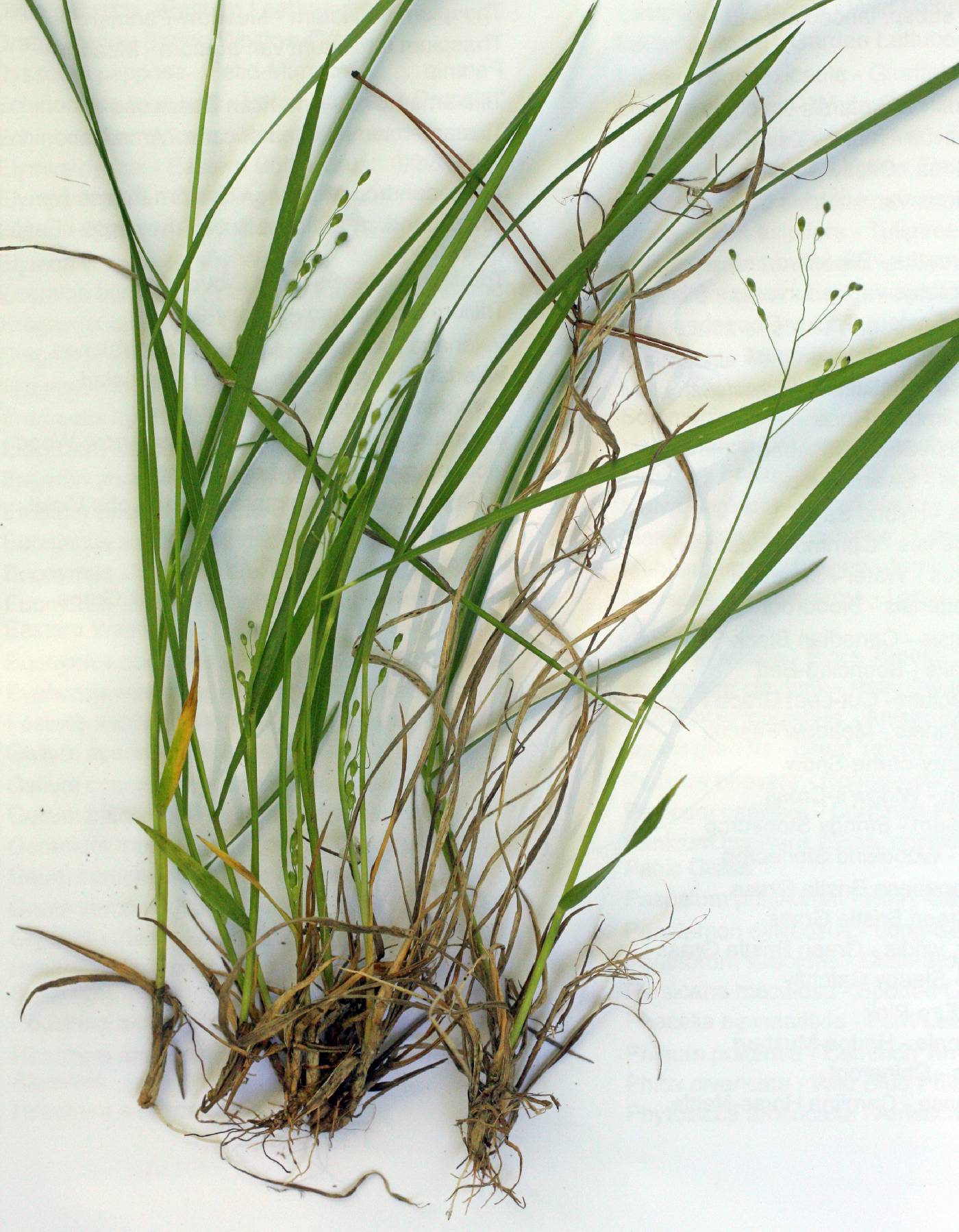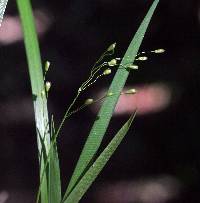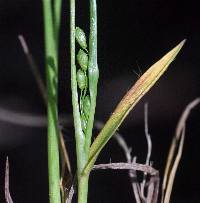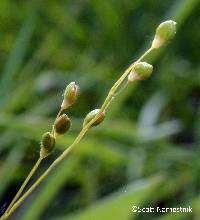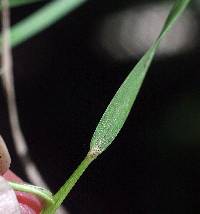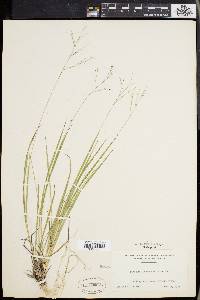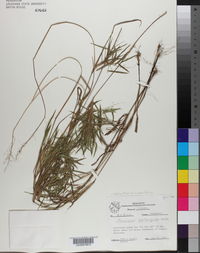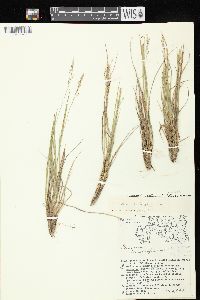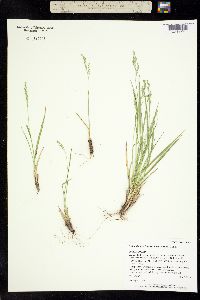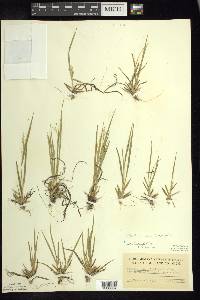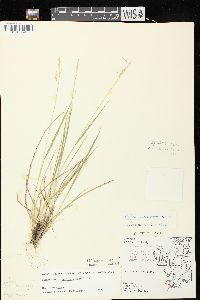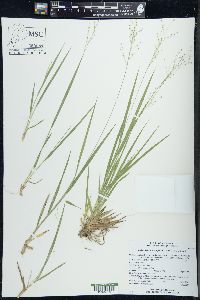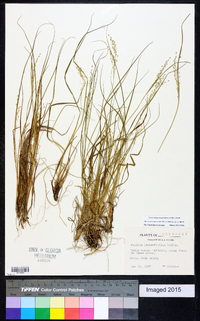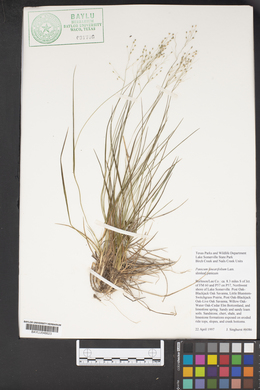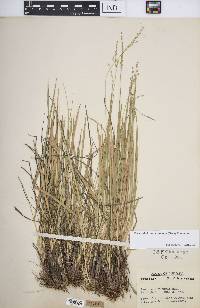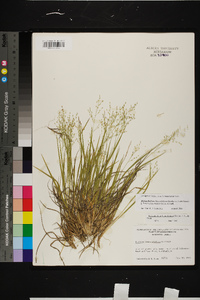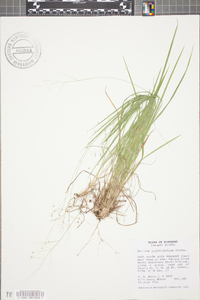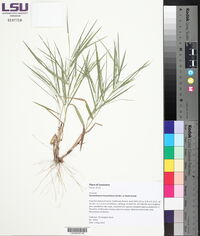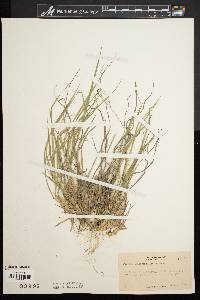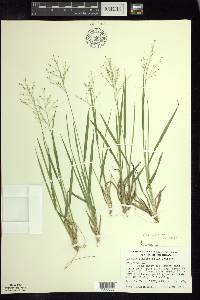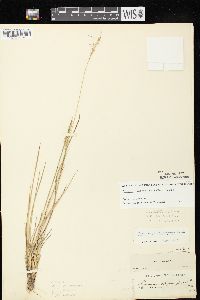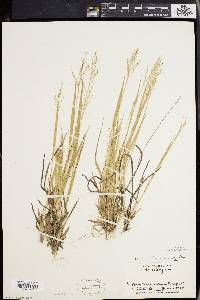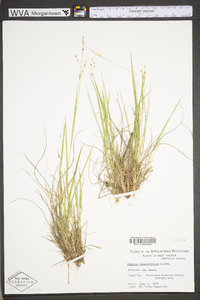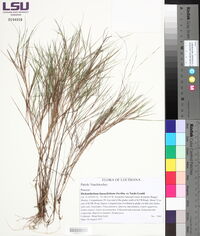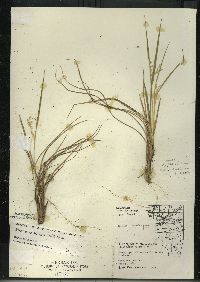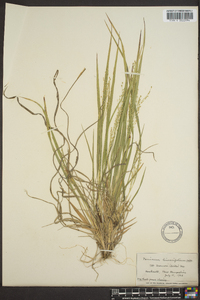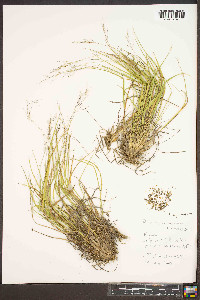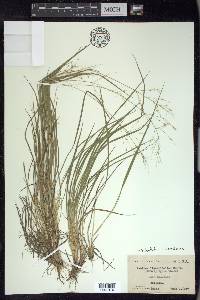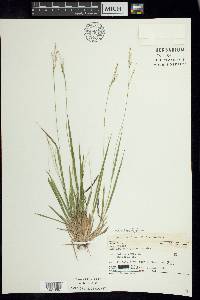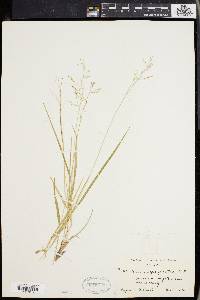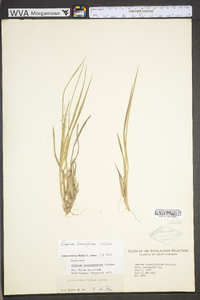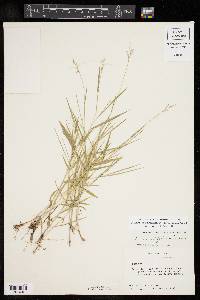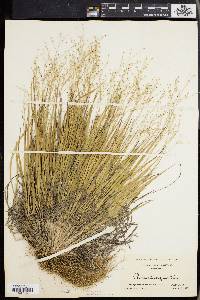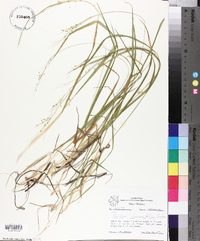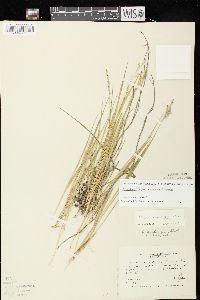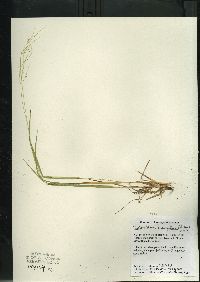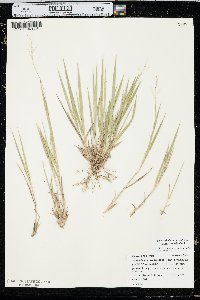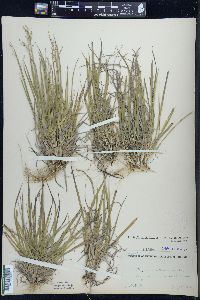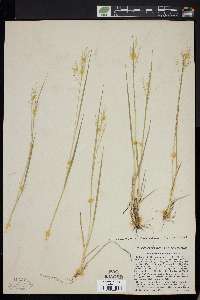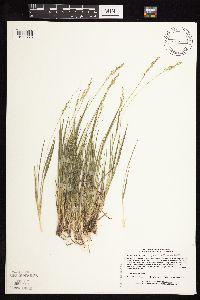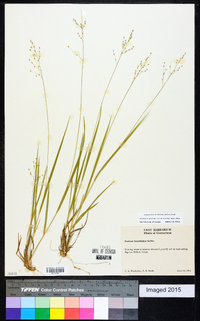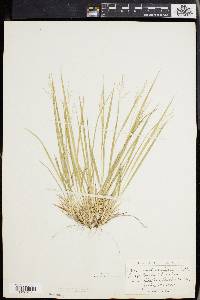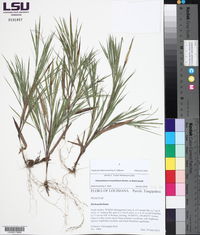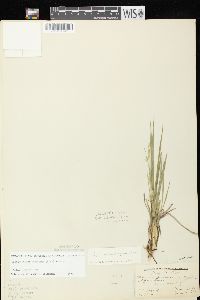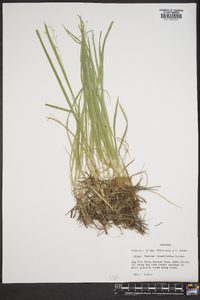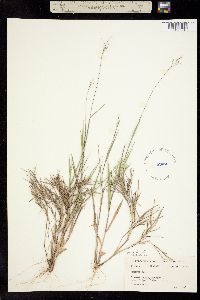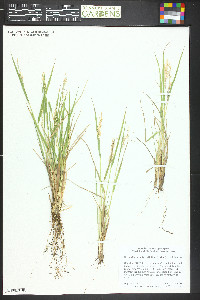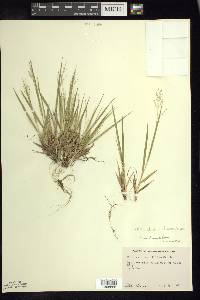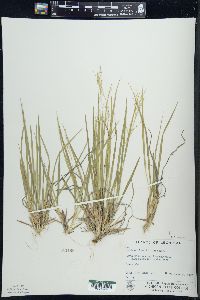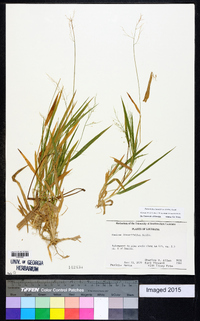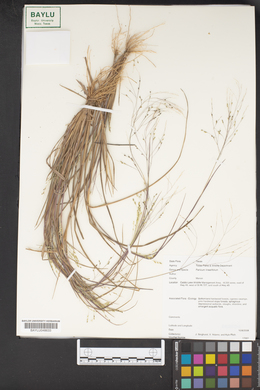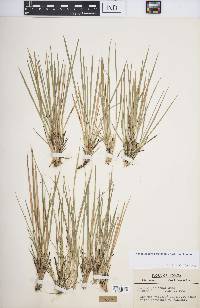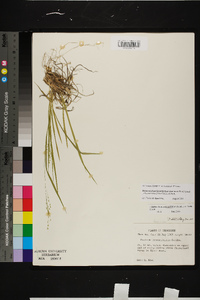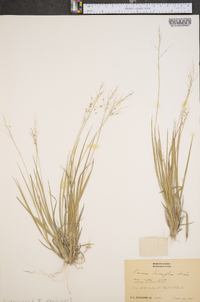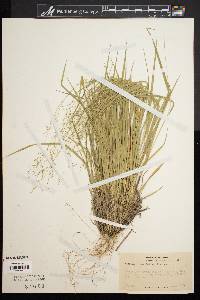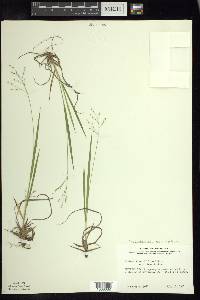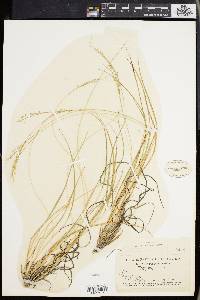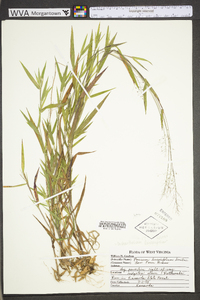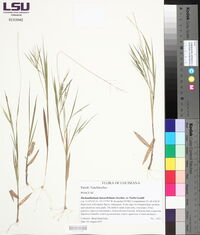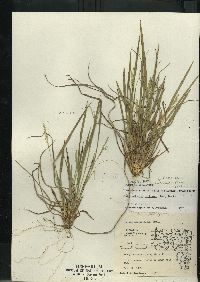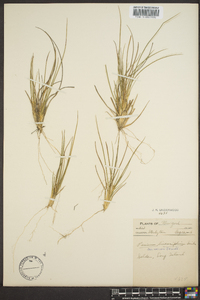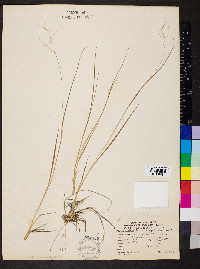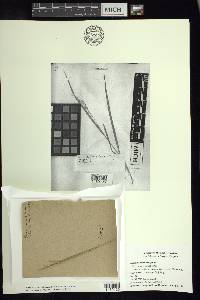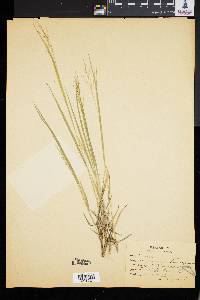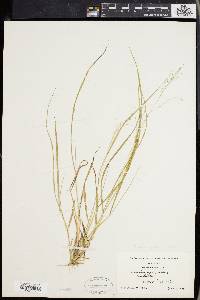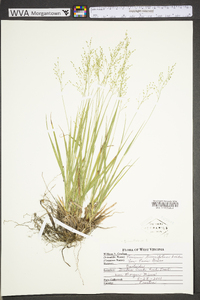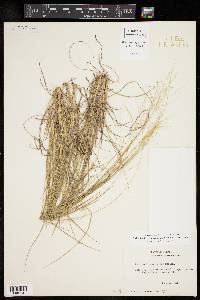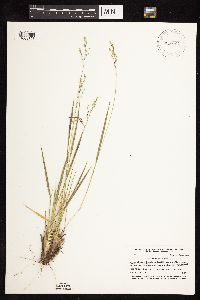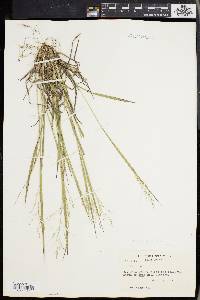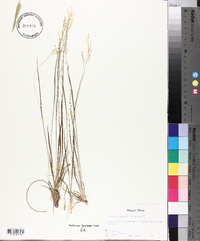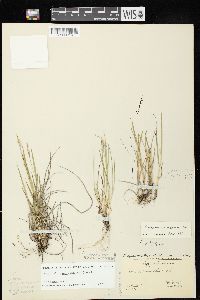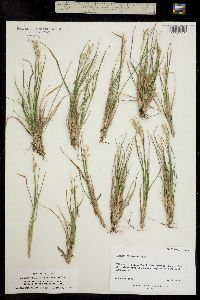Dichanthelium linearifolium
|
|
|
|
Family: Poaceae
Slim-Leaf Witch Grass, more...linear-leaved panicgrass, Long-Stalked Panicgrass (fr: Panic à Feuilles Linéaires)
[Dichanthelium depauperatum var. perlorgum, moreDichanthelium linearifolium var. werneri (Scribn.) Mohlenbr., Dichanthelium perlongum (Nash) Freckmann, Panicum linearifolium F.L.Scribner, Panicum linearifolium var. werneri Fernald, Panicum pammeli Ashe, Panicum perlongum Nash, Panicum strictum var. linearifolium Farw., Panicum strictum var. perlongum (Nash) Farw., Panicum werneri F.L.Scribner] |
Plants cespitose. Basal rosettes poorly differentiated; blades similar in shape to the lower cauline blades, narrow, ascending. Culms 10-50 cm, very slender, erect to drooping, lower 3-8 internodes telescoped together, less than 2 cm, upper 2 internodes elongated; nodes bearded; internodes pubescent to almost glabrous; fall phase developing a dense mass of erect blades and foreshortened branches arising from the basal nodes, terminating in small, narrow secondary panicles that are enclosed within the sheaths, with 6-15 spikelets. Cauline leaves 2-4; sheaths longer than the internodes, glabrous or pilose with dense, fine, papillose-based hairs; ligules about 0.5 mm; blades 5-20 cm long, 2-5 mm wide, stiffly ascending to erect, green to grayish-green, glabrous or densely pilose, apices long-tapering, lower blades shorter than the upper 2 or 3 blades. Primary panicles 4-10 cm long, 2-6 cm wide, long-exserted, with 12-70 spikelets; branches and pedicels spreading. Spikelets 2-3.2 mm long, 0.8-1.4 mm wide, ellipsoid, not turgid, sparsely pubescent. Lower glumes 0.6-1.1 mm, ovate-triangular; upper glumes and lower lemmas exceeding the upper florets by about 0.2 mm before flowering, subequal in fruit, slightly pointed at maturity, upper florets 1.7-2.3 mm, ovoid-ellipsoid, minutely umbonate. 2n = 18. Dichanthelium linearifolium grows in dry, open woodlands, rock outcroppings, and sandy areas. It is restricted to the Flora region. The primary panicles are briefly open-pollinated, produced from May to early June; the secondary panicles are cleistogamous, produced from late June through July (rarely in fall). Plants in the northern United States and Canada tend to be shorter and more spreading, subglabrous, and to have spikelets 2-2.6 mm long; they have been called Panicum werneri Scribn., but do not merit taxonomic recognition. In the southwestern part of its range, especially in the Ozarks, most plants of D. linearifolium are tall, erect, densely pilose, with very elongated blades and spikelets often 2.6-3 mm long; they may hybridize with D. perlongum. Plants densely cespitose. Basal rosettes poorly developed; sheaths 2-4 cm; blades similar in shape to the lower cauline blades, narrow, ascending. Culms 10-50 cm, erect, lower 3-6 internodes telescoped together, forming a slender 2-4 cm column, upper 2 internodes elongated; nodes bearded; internodes puberulent and pubescent; fall phase with sterile branches arising near ground level and foreshortened reproductive branches arising from the higher nodes, secondary panicles small and narrow, enclosed within the sheaths, with 5-10 spikelets. Cauline leaves 2-4; sheaths longer than the internodes, pilose; ligules about 0.5 mm; blades 5-20 cm long, 1-3.5 mm wide, stiffly erect, long-tapering, sometimes involute, green or grayish-green, pubescent to pilose, upper 2 or 3 blades much longer than those below. Primary panicles 3-8 cm long, 1-3 cm wide, narrowly ellipsoid, long-exserted, with 12-25 spikelets; branches ascending; pedicels 2-4 mm, appressed. Spikelets 2.6-3.4 mm long, 1-1.7 mm wide, ellipsoid-obovoid, turgid, finely pubescent. Lower glumes 1-1.4 mm, broadly ovate; upper glumes and lower lemmas exceeding the upper florets by 0.2-0.3 mm before flowering, slightly pointed at maturity, upper florets obovoid, 1.9-2.7 mm, minutely umbonate. 2n = 18. Dichanthelium perlongum grows in dry to mesic prairies, and is restricted to the Flora region. It appears to hybridize occasionally with D. depauperatum and D. linearifolium. The primary panicles are briefly open-pollinated and develop from May to early June; the secondary panicles are cleistogamous and are produced from mid-June through mid-July. Dichanthelium perlongum is similar to D. wilcoxianum, but differs in having only the upper 1 or 2 blades greatly elongated (usually more than 20 times longer than wide), narrow, erect basal blades, and a contracted panicle with ascending branches. Dichanthelium acuminatum also may also be confused with D. perlongum only if its upper internodes elongate, as tends to be the case after a spring fire, but D. acuminatum has less turgid spikelets and hairs in the ligule area that are 3-5 mm long. Perennial herb, tufted 10 cm - 0.5 m tall Inflorescence: a terminal, branched arrangement of spikelets (panicle). Primary panicles atop the culms, 4 - 10 cm long, 2 - 6 cm wide, well-exserted, with twelve to seventy spikelets. Secondary panicles (when present) atop the branches. Fruit: a caryopsis, indehiscent, enclosed within the persistent lemma and palea. Culm: upright to drooping, 10 cm - 0.5 m long, very thin, round in cross-section, hollow, nearly hairless to hairy. Lower internodes much shorter than the elongated upper two internodes. Nodes bearded. Fall phase a dense mass of upright leaf blades and shortened branches, arising from the basal nodes, producing small secondary panicles which remain within the sheaths. Spikelets: 2 - 3 mm long, 0.5 - 1.5 mm wide, ellipsoid, sparsely hairy. Basal leaves: in a rosette. Blades ascending, narrow, similar in shape to lower stem leaves. Stem leaves: two to four, alternate, two-ranked. Sheaths longer than internodes, sometimes softly hairy with fine, bumpy-based hairs. Ligules about 0.5 mm long, composed of hairs. Blades stiff, upright to ascending, 5 - 20 cm long, 2 - 5 mm wide, long-tapering to the tip, parallel-veined, sometimes densely soft-hairy. Glumes:: Lower glumes 0.5 - 1 mm long, egg-shaped to triangular. Upper glumes more or less equal to upper florets, slightly pointed at the apex. Lemmas:: Lower lemmas similar to upper glumes, more or less equal to upper florets, slightly pointed at the apex. Upper lemmas longitudinally lined, shiny, with rolled-up margins above. Paleas:: Lower paleas shorter than lower lemmas, thin. Upper paleas longitudinally lined. Florets:: Upper florets bisexual, stalkless, 1.5 - 2 mm long, egg-shaped to ellipsoid with a minute protuberance at the apex, plump. Anthers three. Stigmas red. Similar species: No information at this time. Flowering: late May to mid-June Habitat and ecology: Local in open sandy soil near Lake Michigan. Occurence in the Chicago region: native Etymology: Dichanthelium comes from the Greek words di, meaning twice, and anth, meaning flowering, referring to plants that may have two flowering periods. Linearifolium means linear-leaved. Author: The Morton Arboretum Vegetatively much like no. 17 [Panicum depauperatum Muhl.], avg somewhat taller and eventually more branched; primary panicle more numerously fld, usually much surpassing the lvs, at maturity open, the longest pedicels 8-18 mm; spikelets ellipsoid, 1.7-3.1 mm, glabrous to pilose; second glume and sterile lemma blunt, about equaling the fr; 2n=18. Dry or stony soil, open woods, and banks; N.S. and Que. to Minn., s. to Ga. and Tex. (P. werneri; Dichanthelium l.) Occasional plants intermediate toward no. 17, called P. perlongum Nash, may be of hybrid origin. Gleason, Henry A. & Cronquist, Arthur J. 1991. Manual of vascular plants of northeastern United States and adjacent Canada. lxxv + 910 pp. ©The New York Botanical Garden. All rights reserved. Used by permission. From Flora of Indiana (1940) by Charles C. Deam Infrequent in the unglaciated area of the southern part of the state and in sandy habitats of the lake area. In the south it is found in open woodland on the crests of ridges, and in the lake area it is found in dry, sandy soil on open dunes, sandy knolls, and sandy ridges. From Flora of Indiana (1940) by Charles C. Deam This is an infrequent species in the sand areas of the northern part of the state. It is found in very dry soil on the crests of open dunes and on sandy knolls and ridges, sometimes in dry, sandy prairies. ...... Indiana Coefficient of Conservatism: C = 7 Wetland Indicator Status: n/a |

